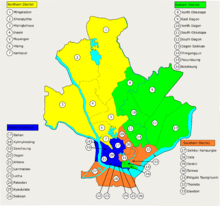Timeline of Yangon
Prior to 19th century
| History of Myanmar |
|---|
 |
|
|
|
|
- 6th century CE - Dagon village founded by the Mon people.
- 7th century - Town conquered by King Punnarika of Pegu, renamed "Aramana."[1]
- 1362 - Binnya U raised the height of Shwedagon Pagoda[2]
- 1364 - Mon Princess Maha Dewi, a sister of King Binnya U became Governor of Dagon.[3]
- 1413 - Town occupied by Burmans.[1]
- 1415 - Mon Prince Binnya Set became Governor of Dagon.[4]
- 1460 - Palace built by Mon Queen Shin Sawbu.[5]
- 1484 - Great Bell of Dhammazedi presented.
- 1583 - Italian merchant, Gasparo Balbi visits.[6]
- 1755 - Dagon captured by Burman King Alaungpaya and renamed "Yangon."[7]
- 1756 - Between 1756-59 Alaungpaya appointed Mon Governor of Yangon, Smim Noradecha (Ma Pu) joins Mon rebellion (approximate date).[8]
- 1768 - Earthquake.[9]
- 1790 - The Mon people (also known as Peguans) in power.[5]
- 1790s - British East India Company factory in business (approximate date).[5]
19th century
- 1823
- Population: 30,000 (estimate).[10]
- Guanyin Gumiao Temple built
- 1824 - Battle of Rangoon.
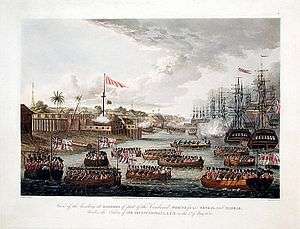 Battle of Rangoon
Battle of Rangoon - 1825 - British in power.[1]
- 1827 - British occupation ends per Treaty of Yandabo.[5]
- 1841 - King Tharrawaddy in residence; city wall built.[9]
- 1850 - Fire.[11]
- 1852
- April: Second Anglo-Burmese War begins; British in power.[1]
- City becomes capital of British Burma.[1]
- 1853 - Port of Rangoon established.[12]
- 1854 - Rangoon Chronicle begins publication.
- 1855
- A Mon noble named Maung Khaing becomes the first Magistrate of Yangon (Rangoon)
- Maung Htaw Lay restores Shwedagon Pagoda [13]
- 1857 - BI Steam Navigation Company starts Calcutta-Rangoon-Moulmein service.
- 1860 - St. Paul's English High School established.
- 1861 - Kheng Hock Keong built
- 1868 - Irrawaddy Flotilla Company starts Rangoon-Mandalay service.[14]
- 1872
- 1874 - 31 July: Municipality constituted.[5]
- 1875 - Fushan Temple built.
- 1876 - City area expanded.[7]
- 1877
- Railway begins operating.[12]
- Central Railway Station built.
- Long Shan Tang Temple built.
- 1878 - Rangoon College established.
- 1879 - City "separated from Hathawaddy District."[5]
- 1881 - Population: 134,176.[16]
- 1882 - Methodist Episcopal Girls School founded.
- 1883
- Inya Lake created.
- Twante Canal opens.
- 1887 - Dufferin Hospital opens
- 1888 - Income tax established.[5]
- 1891 - Population: 181,210.[16]
- 1893 - June: Riot.[5]
- 1899
- General Hospital founded.
- Saint Mary's Cathedral built.
20th century
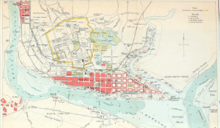
Map of Rangoon, 1911[17]
- 1901
- Strand Hotel opens.
- Population: 234,881.[5]
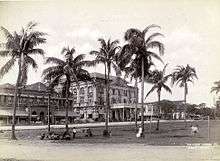 The Strand Hotel, Rangoon
The Strand Hotel, Rangoon
- 1902 - Secretariat Building constructed.
- 1906 - Victoria Memorial Park and Zoological Gardens opens.[17]
- 1907 - Chaukhtatgyi Buddha Temple built.
- 1911 - High Court building constructed.
- 1912 - Gymkhana Ground (cricket) in use.
- 1913 - Burma Art Club founded (approximate date).
- 1914 - Myanma Alin (New Light of Myanmar) newspaper begins.[18]
- 1915 - Lim Chin Tsong Palace built (approximate date).
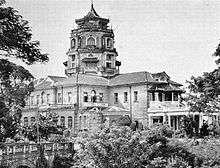 Lim Chin Tsong Palace
Lim Chin Tsong Palace - 1920
- Myoma National High School founded.
- Governor's Residence built.
- 1921 - City boundaries expanded.[7]
- 1922 - City incorporated.[19]
- 1926 - Scott's Market built.
- 1927
- BOC College of Engineering and Mining established.
- Medical school building constructed.
- 1930 - Race riots in Rangoon
- 1931 - Population: 398,967.[12]
- 1936 - Yangon City Hall built.
- 1937 - City becomes capital of Burma.[12]
- 1938 - Race riots in Rangoon
- 1942 - Japanese occupation begins.
- 1943
- Biruma Shinbun newspaper begins publication.[20]
- 8 November: Bombing destroys Botataung Pagoda.
- U Wisara Monument erected.
- 1945 - Japanese occupation ends.
- 1947 - Airport built.
- 1948 - 4 January: City becomes capital of the independent Union of Burma.
- 1952
- National Museum of the Union of Burma opens.
- Kaba Aye Pagoda built.
- 1953 - Population: 711,520.[21]
- 1957 - Kyemon newspaper begins publication.
- 1958 - The Botataung newspaper begins publication.
- 1960
- Population: 1,284,642.[7]
- Yangon Children's Hospital opens
- 1961
- May - South Okkalapa Maternal and Child Hospital opens
- December- 2nd South East Asian Games held
- 1962
- 7 July - Government guns down student protesters.
- Bogyoke Aung San Museum established.
- 1963 - Medical College 2 opens
- 1964 - Institute of Foreign Languages (IFL) opens
- 1967 - 26 June: "Anti-Chinese riot."[22]
- 1968 - Planetarium established.
- 1969 - 5th South East Asian Games
- 1972 - Karaweik built
- 1973 - Population: 2,055,365 (approximate).[23]
- 1974 - Government guns down student protesters following U Thant's death
- 1980 - Maha Wizaya Pagoda built.
- 1983
- 9 October: Bombing at Martyrs' Mausoleum.
- Population: 2,513,023.[24]
- 1984 - New Yangon General Hospital opens
- 1985 - Thuwunna Stadium opens.
- 1988
- 8 August: 8888 Uprising.
- State Law and Order Restoration Council headquartered in city.[25]
- Ko Lay becomes mayor.
- 1989 - City renamed "Yangon."[26]
- 1990
- Yangon City Development Committee established.[19]
- Bayinnaung Market established
- 1991 - National Theatre of Yangon opens.
- 1992 - Asia World Group conglomerate headquartered in city.
- 1993 - Dagon University opens
- 1994 - Thingangyun Sanpya Hospital opens
- 1996 - Myanmar Securities Exchange established.[27]
- 1998 - Myanmar Motion Picture Museum established.
- 1999 - Sakura Tower opens.
21st century
- 2001 - Yangon City FM radio begins broadcasting.
- 2002 - Kyauktawgyi Buddha Temple (Yangon) opens.
- 2005
- May: May 2005 Yangon bombings
- November: National capital relocated from Yangon to Naypyidaw.
- 2007
- September: Anti-government protests led by monks; crackdown.[26]
- Yangon International Airport terminal built.
- 2008
- 2 May: Cyclone Nargis.
- September: Explosion near City Hall.[28]
- 2009 - Yangon United Football Club formed.
- 2010
- 16 April: April 2010 Yangon Thingyan bombings
- Population: 4,348,000.
- 2011
- Hla Myint becomes mayor.
- 2011 Yangon explosion
- 2012
- February: Shwedagon Pagoda Festival resumes.
- Yangon Heritage Trust begins
- 2013
- 2014 - Population: 4,575,155 (2014 census); 5,211,431 (urban agglomeration).[31]
- 2015 - Yangon Stock Exchange begins
- 2017 - Yangon Bus Service begins
gollark: pls repost 782889087416926219
gollark: Really? Hmm.
gollark: https://en.wikipedia.org/wiki/United_States_v._Article_Consisting_of_50,000_Cardboard_Boxes_More_or_Less,_Each_Containing_One_Pair_of_Clacker_Balls
gollark: It's possible for webservers to (very easily) detect if Discord is fetching content, or a normal browser is.
gollark: Wait, it *actually* did and that wasn't a joke?
See also
References
- Smith 1882.
- Harvey, G. E. (1925). History of Burma: from the earliest times to March 1824.
- Pan Hla, Nai (1968). Razadarit Ayedawbon (in Burmese) (8th printing, 2005 ed.). Yangon: Armanthit Sarpay. p. 54.
- Sithu, Maha (1798). Yazawin Thit. 1 (Kyaw Win; Thein Hlaing (2nd ed.) ed.). Yangon. p. 262.
- Gazetteer 1908.
- "Voyage to Pegu, and Observations There, Circa 1583" (PDF). SOAS Bulletin of Burma Research. 2003.
- Nwe 1998.
- Roy, Prominent Mon Lineages from Late Ayutthaya to Early Bangkok, Journal of the Siam Society, 2010, p. 208. Roy points out that the Burmese-appointed governor of yangon Ma Pu joined a Mon rebellion in the 1750s. Since he was appointed by the Burmese, it could be between 1755-59.
- James 2004.
- Morse 1823.
- Britannica 1910.
- Spate 1942.
- Oung, Kin (2007). A Twentieth Century Burmese Matriarch.
- "Irrawaddy River Cruise, Myanmar (Burma)". www.irrawaddyflotilla.com. Retrieved 28 September 2019.
- Balfour 1885.
- "Rangoon", Lippincott's Gazetteer of the World, Philadelphia: J. B. Lippincott, 1893, OCLC 3155661
- Murray 1911.
- "Myanma Alinn Daily".
- Cities And Sustainable Development: Lessons And Experiences from Asia And the Pacific. United Nations Publications. 2003. ISBN 9211203678.
- "Rangoon (Burma) Newspapers". WorldCat. USA: Online Computer Library Center. Retrieved 29 April 2013.
- "Population of capital city and cities of 100,000 or more inhabitants". Demographic Yearbook 1955. New York: Statistical Office of the United Nations.
- Jayde Lin Roberts (2013), "Sin Oh Dan Street Lion Dance Competition", in Jeffrey Hou (ed.), Transcultural Cities, New York: Routledge, ISBN 0415631424
- United Nations Department of Economic and Social Affairs, Statistical Office (1976). "Population of capital city and cities of 100,000 and more inhabitants". Demographic Yearbook 1975. New York. pp. 253–279.
Rangoon
- "Historical Background". Yangon City Development Committee. Archived from the original on 25 February 2013. Retrieved 29 April 2013.
- Seekins 2005.
- "Burma Profile: Timeline". BBC News. Retrieved 29 April 2013.
- "Burma stock exchange planned by Tokyo bourse". BBC News. 11 April 2012.
- "Explosion in Myanmar on anniversary of crackdown". New York Times. 25 September 2008.
- "Myanmar hosts first marathon in decades". Al Jazeera. 27 January 2013.
- "Children killed in Myanmar school fire". Al Jazeera. 2 April 2013.
- "Table 8 - Population of capital cities and cities of 100,000 or more inhabitants", Demographic Yearbook – 2018, United Nations
Bibliography
- Published in the 19th century
- Jedidiah Morse; Richard C. Morse (1823), "Rangoon", A New Universal Gazetteer (4th ed.), New Haven: S. Converse
- "Rangoon". Wright's Australian and American Commercial Directory and Gazetteer. New York. 1881.
- George Smith (1882), "Rangoon", Geography of British India, Political & Physical, London: J. Murray, OCLC 5876009
- Edward Balfour (1885), "Rangoon", The Cyclopaedia of India and of Eastern and Southern Asia (3rd ed.), London: B. Quaritch
- Published in the 20th century
- "Rangoon". Imperial Guide to India, Including Kashmir, Burma and Ceylon. London: John Murray. 1904.
- Richard Barrett Talbot Kelly (1905), "Rangoon", Burma, painted and described, London: Adam and Charles Black, OCLC 5057234
- "Rangoon City", Imperial Gazetteer of India, Oxford: Clarendon Press, 1908
- "Rangoon", Encyclopædia Britannica (11th ed.), New York, 1910, OCLC 14782424 – via Internet Archive
- "Rangoon", A Handbook for Travellers in India, Burma, and Ceylon (8th ed.), London: John Murray, 1911
- C. Morgan Webb (1923). "Development of Rangoon". Town Planning Review. UK. 10. JSTOR 40101637.
- B. R. Pearn (1939), A History of Rangoon, Rangoon: American Baptist Mission Press
- O. H. K. Spate; L. W. Trueblood (1942). "Rangoon: A Study in Urban Geography". Geographical Review. American Geographical Society. 32. JSTOR 210359.
- Noel F. Singer (1995), Old Rangoon: City of the Shwedagon, Scotland: Paul Stachan - Kiscadale, ISBN 1870838475
- Schellinger and Salkin, ed. (1996). "Yangon". International Dictionary of Historic Places: Asia and Oceania. UK: Routledge. ISBN 9781884964046.
- Than Than Nwe (1998). "Yangon: The Emergence of a New Spatial Order in Myanmar's Capital City". Sojourn: Journal of Social Issues in Southeast Asia. 13. JSTOR 41056978.
- Mira Kamdar (1999). "Rangoon: A Remembrance of Things Past". World Policy Journal. 16. JSTOR 40209649.
- Published in the 21st century
- Helen James (2004). "Rangoon". In Ooi Keat Gin (ed.). Southeast Asia: A Historical Encyclopedia. ABC-CLIO. ISBN 1576077705.
- Donald M. Seekins (2005). "The State and the City: 1988 and the Transformation of Rangoon". Pacific Affairs. 78.
- Frauke Kraas; Hartmut Gaese; Mi Mi Kyi, eds. (2006). Megacity Yangon. Berlin: Lit Verlag. ISBN 3825800423.
This article is issued from Wikipedia. The text is licensed under Creative Commons - Attribution - Sharealike. Additional terms may apply for the media files.
